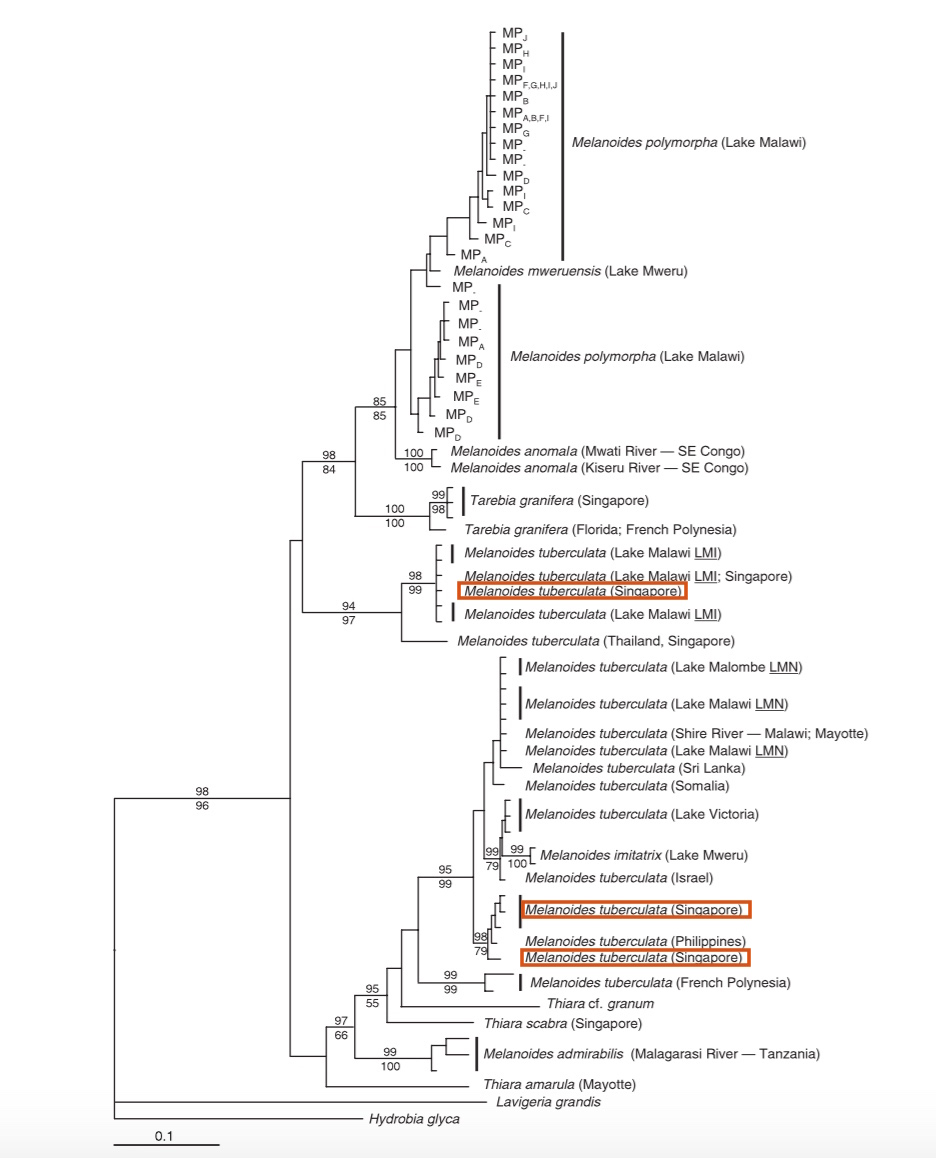Table of Contents
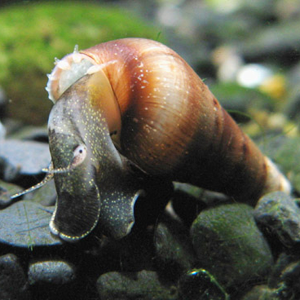 |
| Figure 1. Close up photo of the Red-rimmed melania. Photo by ZXP100 from Photobucket. |
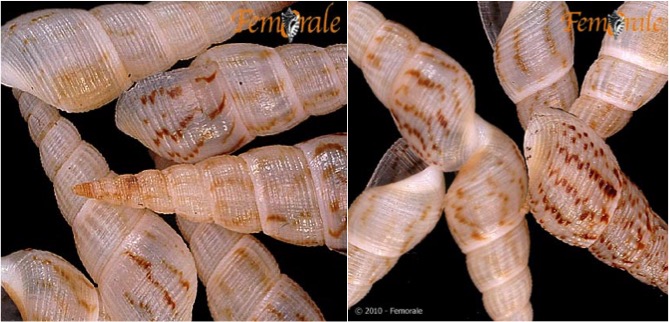 |
| Figure 2. Dead shells of Melanoides tuberculata. Photo posted with permission: © Femorale |
What is this?
Nomenclature
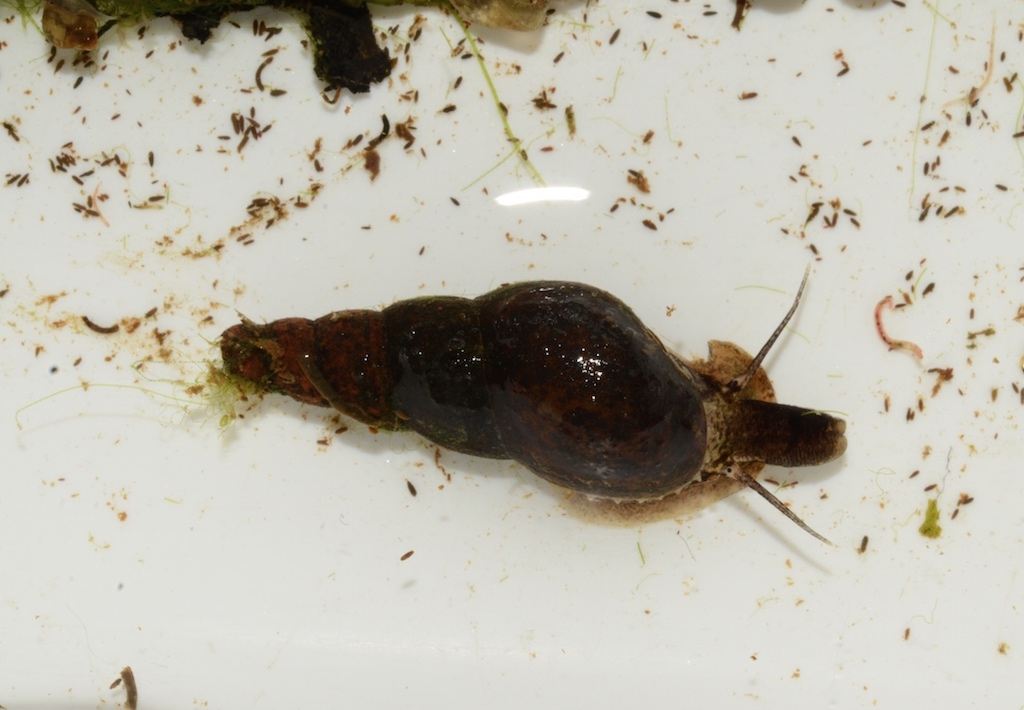 |
| Figure 3. Live red-rimmed melania. © Ng Ting Hui |
| Binomial Name:Melanoides tuberculata Common Name:Red-rimmed melaniaMalaysian Trumpet Snail Etymology (origins of naming):The common name (Red-rimmed melania) comes from the presence of reddish spots on the light-brown shell. |
General Information
Possibly the most ubiquitous freshwater snail in Singapore, Melanoides tuberculata is a hardy species present in almost any kind of water bodies, including brackish drains near the sea[1]. It is a tropical, prosobranch gastropod (see Taxonomy and Systematics) also commonly known as a snail.Why is something called a gastropod anyway? A large part of a snail's body can be seen extended outside of the shell, when the snail is crawling around. This body part is flattened at the belly side (ventrally) to form a flat crawling sole and mainly is used for locomotion. This is why it is consequently called the foot (see Morphology and identification) that snails crawl on their belly has provided them with their scientific name: Gastropoda, the belly-foot animals. Prosobranchs are known to have a loop of visceral nerves that are twisted into a figure eight and are gonochoric (see Reproductive Characteristics) and most of time an operculum that covers the aperture (see Morphology and identification).
What is interesting about Melanoides tuberculata is that it exhibits extensive variation in shell ornamentation, in terms of the coloured patterns and sculptures, hence the term polymorphism[2]. It also has a significance of being a bioindicator as it is a benthic macrofauna (see Ecological Significance).
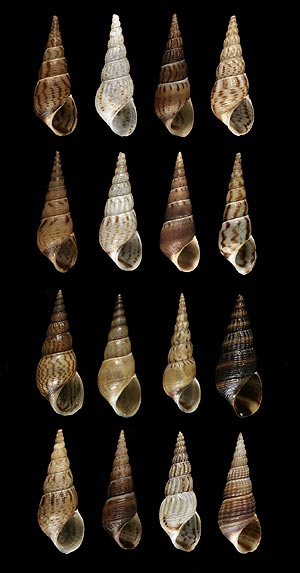 |
| Figure 4. Variations in shell pattern of Melanoides tuberculata. Photo posted with permission: © Jean-Pierre Pointier |
| Why is there a variation in shell pattern? |
While studies are still ongoing, preliminary studies have shown that that genetic variation, sexual dimorphism, and phenotypic plasticity may all significantly increase the amount of variation in shell shape[3]. Rapid changes of shell morphology may actually be due to invasions of new genotypes, where closely related species show different shell shapes. Also, sexual dimorphism would mean that there would naturally be phenotypic differences between males and females of Melanoides tuberculata. As for phenotypic plasticity, it may be triggered by environmental changes, which may then override genetically based morphological variation.
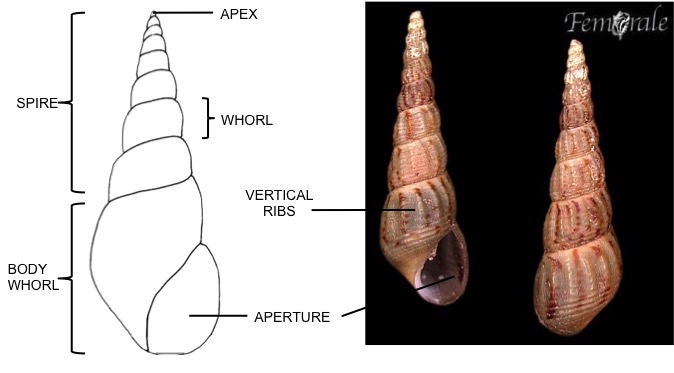 |
| Figure 5. Anatomy of the shell. Photo posted with permission: © Femorale. Images edited by Joanne Song. |
Morphology and Identification
(i) Shell
With an elongated conical shell that has regularly increasing whorls, the morphology of most of the adults include a pale to dark brown shell colour[4] with many reddish-brown spots or "flame" looking like pattern[5]. The aperture always faces to the right. Prominent vertical ribs are usually present on the middle and upper whorls of the shell (link to picture to show the shell anatomy). Adult snails typically reach a shell length of 30–36mm, though there have been reports of lengths reaching up to 80mm[6]. Also, identification of snails is usually done with the aperture facing upwards, and checking which direction (leftward or rightward) the aperture faces.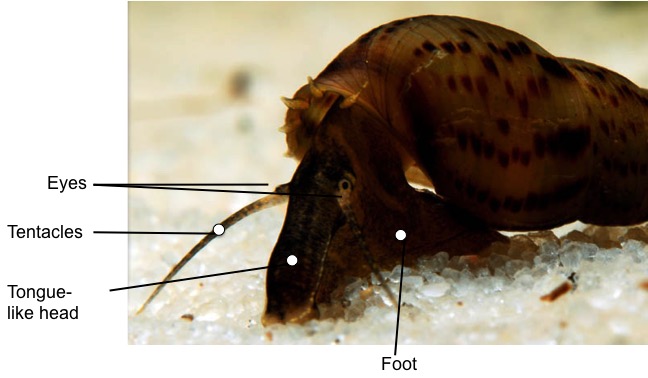 |
| Figure 6. Features of the snail body. Image by: © David Oscar; Madrid, Spain. Edited by: Joanne Song |
(ii) Body
Melanoides tuberculata has a tongue-like head that is constricted on its ventral side to give rise to the foot. The tentacles are just above the constricted area and right at the base of each long and slender tentacle; the eyes are present there[7]. For a live video of the body movement of M. tuberculata, refer to Video 1 below. It will feature the snail sliding across rocks in an aquarium tank.Video 1. Showing the body form and movement of M. tuberculata in an aquarium tank.
“Turmdeckelschnecke Melanoides tuberculata 2.”, by Nordamerika Aquariumfisch Zucht (Notropis chrosomus) by YouTube Channel, 1 November 2009. URL: https://www.youtube.com/watch?v=rSJrqCTSq54 (accessed on 11 Nov 2014)
<In English: Tower snail Melanoides tuberculata 2.”, by North America aquarium fish breeding (Notropis chrosomus) by YouTube Channel, 1 November 2009. URL: https://www.youtube.com/watch?v=rSJrqCTSq54 (accessed on 11 Nov 2014)>
How did the description of this species come about in the first place?
Originally in Latin, Melanoides tuberculata was first described as Nerita tuberculata. Some descriptions of this writing (using Google translate) include "whitish, elongate, wavy lines, sharp exterior, single operculum spot". It is believed to be found in India, Chennai, near Coromandel shore (Figure 8). This is interesting because Melanoides tuberculata is actually a freshwater snail. Yet the very first description was of it being at the 'littore' (Latin) zone.
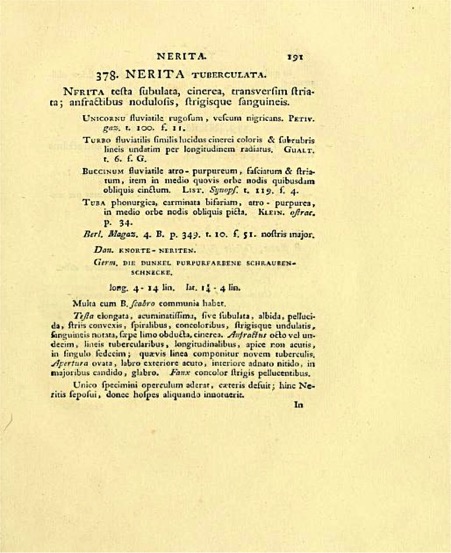 |
| Figure 7. Original description of Nerita tuberculata in Latin (page 191). Today, it is known as Melanoides tuberculata. Extracted from Müller (1774). Image courtesy of Biodiversity Heritage Library. http://www.biodiversitylibrary.org. |
 |
| Figure 8. Original description of Nerita tuberculata in Latin (page 191). Today, it is known as Melanoides tuberculata. Extracted from Müller (1774). Image courtesy of Biodiversity Heritage Library. http://www.biodiversitylibrary.org. |
Back to Top
Where can it be found?
Geographical Distribution
(i) Global Distribution
o Found mostly in Asia, South America and South Africa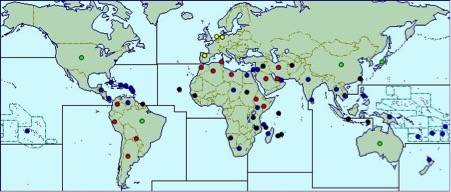 |
| Figure 9. Map showing the global distribution of Melanoides tuberculata. Image source: CABI’s Invasive Species Compendium (ISC) data sheet. |
 = Present, no further details = Present, no further details |
 = Evidence of pathogen = Evidence of pathogen |
 = Widespread = Widespread |
 = Last reported = Last reported |
 = Localised = Localised |
 = Presence unconfirmed = Presence unconfirmed |
 = Confined and subject to quarantine = Confined and subject to quarantine |
 = See regional map for distribution within the country = See regional map for distribution within the country |
 = Occasional or few reports = Occasional or few reports |
(ii) Local Distribution
o Found in catchment reservoirs, estuarine reservoirs, rural streams, ponds and monsoon canals of Singapore.
Back to Top
How does it live?
Biology
(i) Habitat
M. tuberculata may resist a broad spectrum of environmental conditions. Typically, it can be found in either naturalized lentic or lotic habitats such as rivers and streams, lakes, but also anthropized aquatic environments like garden ponds, reservoirs and dams[12]. It is found in shallow slow running water with a range of depth of 0.6m-1.2, on a substratum consisting of soft mud, or soft mud and sand. But it has also been reported from relatively deep portions of freshwater pools (3 m deep) with substrata composed largely of rocks[6]. Moreover, these snails have been studied to be associated with different types of substrates; rock, gravel, mud, clay and sand. It is also often associated with macrophytes and structures (plastic or wood) that have been introduced by man[13]. M. tuberculata is also known to support a wide range of salinity conditions. As long as the water is well oxygenated, M. tuberculata shows high resistance against pollution[14]. Its ability to tolerate living in such harsh conditions is probably related to its life history traits.(ii) Diet
M. tuberculata is a polyphagous species[9]. It is an aquatic herbivorous snail that feeds on benthic, epiphytic and periphytic algae[10]. These snails have radula that is used in the grazing of the algae (Take a look at Video 2 for a close up view on what a radula looks like). Gut analyses have also indicated that M. tuberculata consume microalgae (e.g. diatoms), fine detritus and organic particles deposited on the sediment[11]. Hence, it is likely that M. tuberculata is a generalist and detritivore.Video 2. Showing the mouth part, radula, of Melanoides tuberculata grazing about.
“Red-rimmed melanis grazing” by SupremeKai Channel, 1 October 2014.
URL: https://www.youtube.com/watch?v=wzIQrPTftBw (assessed on 11 Nov 2014)
(iii) Reproductive Characteristics and Live History
M. tuberculata reproduces mainly through parthenogenesis, in which the unfertilised egg is able to develop into a new individual in the absence of the male gamete. The ova is also being produced mitotically, though there are some rare events of sexual reproduction[15]. This species is ovoviviparous and juveniles are incubated in the brooding pouch of females, which have a wider last shell whorl than males[16].The number of young within the brood pouch ranges from one to 70 individuals, depending on the size of the adult and on the morph considered[17]. The new-borns usually measure between 1mm and 4mm, and their shells consist of a small protoconch and the first two whorls[18].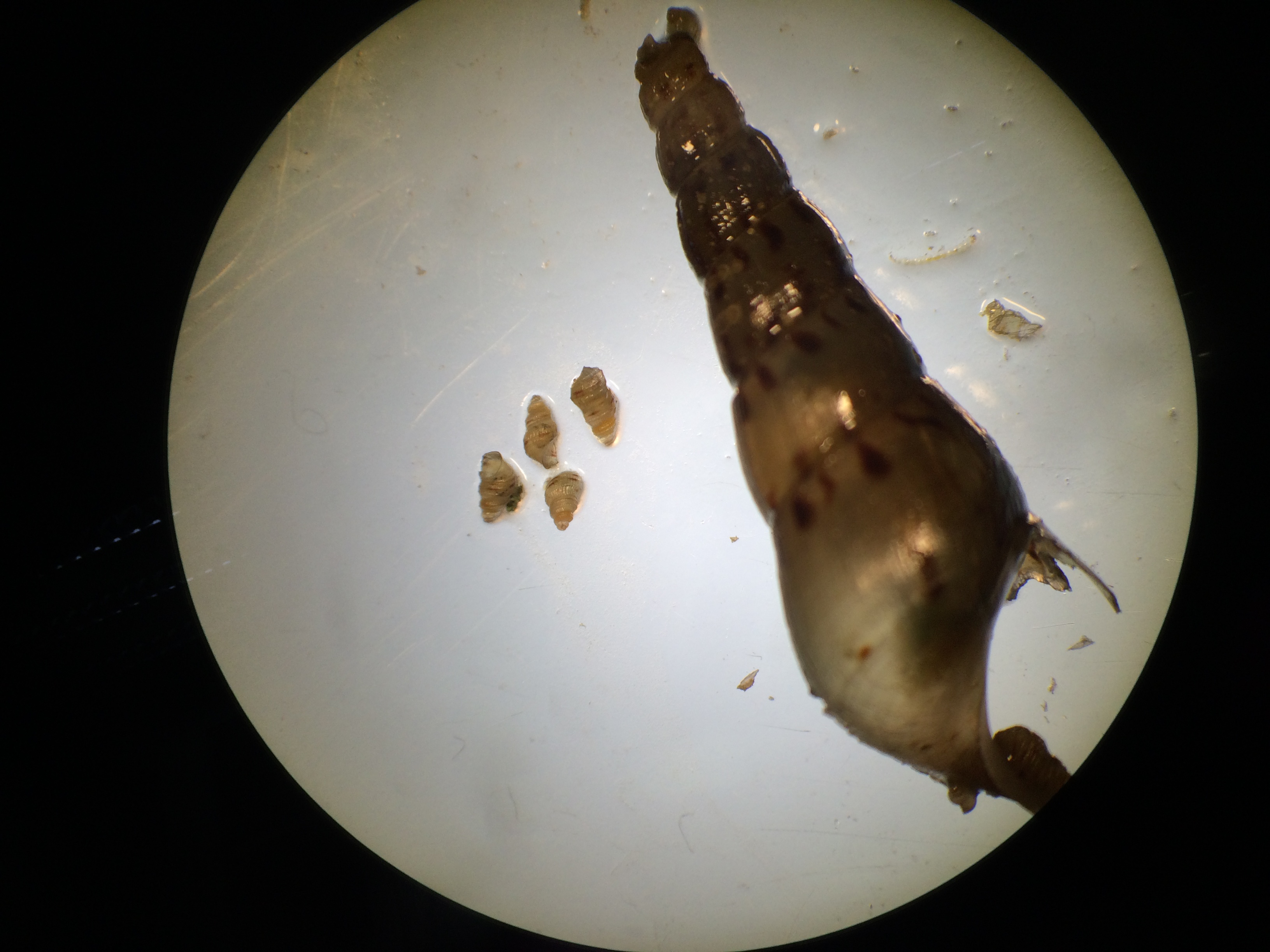 |
| Figure 11. Microscopic view of juvenile snails that were found in the brooding pouch of the adult snail. © Joanne Song |
o While reproduction rates of M. tuberculata are low compared to other pulmonate snails, it has low mortality rates and a long life span. Such life history strategies enable it to live in permanent and stable habitats, and also to have competitive advantage over other species of snails. In addition to this competitive advantage, M. tuberculata seem to be able to maintain high population densities over a long period of time, leading to conclusions that intraspecific competition does not seem to affect much of its population size in the same area[19].
Back to Top
Are there any impacts on the environment or on humans?
Ecological Significance
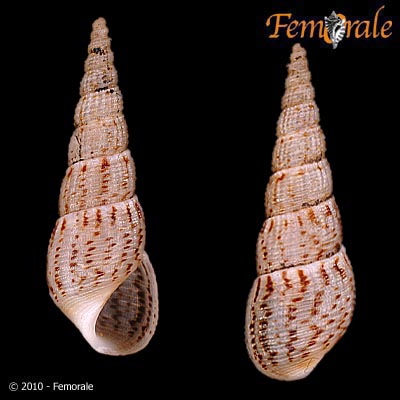 |
| Figure 12. Dead shells of Melanoides tuberculata. Photo posted with permission: © Femorale |
In addition, the Red-rimmed Melania are found to be good bioindicators of water quality. When seen above water, it indicates that there may be issues with the quality of the water as they cannot bear high saline waters. While they are resistant to some other factors like high pH levels and low oxygen saturation levels, water with high pH levels tend to break down their shells. Hence, they serve as good bioindicators[20].
Human Health
While this is not of a huge concern to Singapore, it is a fact that Melanoides tuberculata is of medical importance because it serves as first intermediate host for human lung fluke, Paragonimus westermani. Also, red-rimmed Melania are also a vector for several important diseases. They are the intermediate host for a number of trematode parasites including: Clonorchis sinensis, the Chinese liver fluke; Paragonimus westermani, the Oriental lung fluke; Diorchitrema formosanum, an intestinal trematode; Opisthorchis sinensis, the human liver fluke; and Philophthalmus sp., the avian eye fluke[21].Back to Top
Is there information on Taxonomy and Systematics?
Synonyms
Melania trunculata Lamarck, 1822Melanoides fasciolata Oliver, 1804Melanoides tuberculatus (Müller, 1774)
Type Information
Holotype ‘presumed lost’[22]Classification
EukaryotaMetazoa
Mollusca
Gastropoda
Prosobranchia
Mesogastropoda
Discopoda
Cerithioidea
Thiaridae
Melanoides
Melanoides tuberculata
Phylogenetic Relationships
This phylogenetic tree was done up based on mitochondrial DNA sequences on different freshwater snails that can be found at Lake Malawi. It was hypothesized that such ancient lakes have high taxa diversity due to the historically stable environments. This has allowed the accumulation of lineages over evolutionary timescales. In this paper by Genner et al. (2007), the evolution of a unique morphologically diverse assemblage of thiarid gastropods belonging to the Melanoides polymorpha 'complex' was examined. It was discovered that this 'complex' was not monophyletic, but in fact it shared a common ancestry with many other species of Melanoides, including the Singaporean species Melanoides tuberculata.
According to Genner et al. (2007), two deep mitochondrial clades currently referred to Melanoides tuberculata have colonized Lake Malawi independently. One clade is a recent introduction into Lake Malawi and has Southeast Asian ancestry, the second clade is widespread throughout East Africa, and is also present in Israel and Sri Lanka[24]. This denotes that there could be possible cryptic species under the same name 'Melanoides tuberculata'. This is the case even for Singapore, as seen in the phylogenetic tree above. This certainly calls for a debate; Since the phylogenetic tree shows two different clades, does this not mean that there are two species of Melanoides tuberculata found in Singapore? Perhaps there has to be some sort of sub-species for Melanoides tuberculata in Singapore. However, this has not yet been verified or are there papers on this issue.
Back to Top
Glossary of Terms
| Aperture |
The opening of a gastropod shell, which the animal’s body and head emerge from. |
| Gonochoric |
Sexes that are usually separate |
| Lentic |
Still waters. |
| Lotic |
Flowing waters. |
| Ovoviviparous |
Giving birth to live offspring that have hatched from eggs within the body. |
| Parthenogenesis |
Form of reproduction where the egg develops to a new individual without fertilization. |
| Polyphagous |
Able to feed on various kinds of food. |
| Protoconch |
The first or earliest or original shell, which is an embryonic or larval shell which occurs in some classes of Molluscs. e.g., the initial chamber of an ammonite or the larval shell of a gastropod. |
| Radula (plura radulae or radulas) |
An anatomical structure used by molluscs for feeding. It is a minutely toothed, chitinous ribbon, which is typically used for scraping or cutting food before the food enters the oesophagus. |
Back to Top
Related Links
To find out more information on Melanoides tuberculata, you may want to click on the following links:
1. Species page by CABI < http://www.cabi.org/isc/datasheet/75617 >
2. An identification manual of freshwater snails found in Florida < An identification manual for the freshwater snails of Florida >
3. Species page and conservation details by IUCN < http://www.iucnredlist.org/details/155675/ >
4. Description and articles on Melanoides tuberculata < http://www.animalspot.net/melanoides-tuberculata.html >
5. General information about Molluscs < http://molluscs.at/gastropoda/index.html >
Back to Top
References and Links
[1] Tan, S. K., Chan, S. Y. and Clements, G. R., 2012. A Guide to Snails and other Non-marine Molluscs of Singapore. Science Centre, Singapore. 176pp.
[2] Lau, S., Mohamed, M., Tan, A. C. Y. and Su’ut, S., 1998. Accumulation of heavy metals in freshwater molluscs. The Science of the Total Environment, 214: 113–121.
[3] Samadi, S., David, P. and Jarne, P., 2000. Variation of shell shape in the clonal snail Melanoides tuberculata and its consequences for the interpretation of fossil series. Evolution, 54(2): 492–502.
[4]Thompson, F. G., 1984. The freshwater snails of Florida: A manual for identification. University of Florida Press, Gainesville. 94p.
[5] Pointier, J. P. 2001. Invading freshwater snails and biological control in Martinique Island, French West Indies. Rio de Janeiro. 96: 67–74.
[6] Murray, H. D., 1975. Melanoides Tuberculata (Muller), Las Morras Creek, Bracketville, Texas. Bulletin of the American Malacological Union, Inc., 1975:43.
[7] Lee, V., 1973. Some common snails of vegetable fields in Hong Kong. Agriculture Hong Kong, 1(2): 123–129.
[8] Clements, G. R., 2002. Occurrence and Distribution of Primary Freshwater Molluscs in Singapore. Unpublished student report, National University of Singapore, Singapore. 28 pp.
[9] Madsen, H., 1992. Food selection by freshwater snails in the Gezira irrigation canals, Sudan. Hydrobiologia, 228(3): 203–217.
[10] Dudgeon, D., 1989. Ecological strategies of Hong Kong Thiaridae (Gastropoda: Prosobranchia). Malacological Review, 22: 39–53.
[11] Subda Rao, N. V. and Mitra, S. C. C., 1982. Bioecology of two melaniid snails (MolluscaL Gastropoda) in ponds near Calcutta. Journal of the Zoological Society of India, 34(1-2): 21–32.
[12] Vogler, R. E., Nunez, V., Gutierrez Gregoric, D. E., Beltramino, A. A. and Peso, J. G. (2002). Melanoides tuberculata: The History of an Invader. In: Hamalainen, E. M. and Jarvinen, S. (eds) Snails: Biology, Ecology and Conservation. Nova Science Publishers, Inc, New York, p 64–84.
[13] Da Silva, R. E., Melo, A. L., Pereira, L. H. and Frederico, L. F., 1994. Levantamento malacologico da bacia hidrografica do Lago Soledade, Ouro Branco (Minas Gerais, Brasil). Revista do Instituto de Medicina Tropical de Sao Paulo, 36: 437–444.
[14] Pointier, J., Theron, A. and Borel, G., 1993. Ecology of the introduced snail Melanoides tuberculata (Gastropoda: Thiaridae) in relation to Biomphalaria glabrata in the marshy forest zone of Guadeloupe, French West Indies. Journal of Molluscan Studies, 59: 421–428.
[15] Samadi, S. , Mavárez, J. , Pointier, J. P., Delay, B. and Jarne, P., 1999. Microsatellite and morphological analysis of population structure in the parthenogenetic freshwater snail Melanoides tuberculata: insights into the creation of clonal variability. Molecular Ecology, 8(7): 1141–1153.
[16] Heller, J. and Farstay, V., 1989. A field method to separate males and female of the freshwater snail Melanoides tuberculata. Journal of Molluscan Studies, 55: 427–429.
[17] Livshits, G. and Fishelson, L., 1983. Biology and reproduction of the freshwater snail Melanoides tuberculata (Gastropoda: Prosobranchia) in Israël. Israël Journal of Zoology, 32: 21–35.
[18] Facon, B, Pointier, J. P., Jarne, P., Sarda, V. and David, P., 2008. High genetic variance in life-history strategies within invasive populations by way of multiple introductions. Current Biology, 18(5): 363–367. Available: http://www.cell.com/current-biology/abstract/S0960-9822(08)00239-X
[19] Pointier, J., Toffart, J. and Lefévre, M., 1991. Life tables of freshwater snails of the genus Biomphalaria (B. glabrata, B. alexandrina, B. straminea) and of one of its competitors Melanoides tuberculata under laboratory conditions. Malacologia, 33: 43–54.
[20] Qarooni, I. H. M., Akber, M. M. and Al-Saad, H. T., 2012. Snail Melanoides tuberculata for Shatt Al — Arab river pollution by some heavy metals. Proceedings of The 4th Kurdistan Conference on Biological Sciences, University of Duhok.
[21] Gulf States Marine Fisheries Commission, 2007. Melanoides tuberculata (Müller, 1774). Available: https://archive.today/uItgC#selection-477.757-477.1003 Assessed on 7th November 2014.
[22] OBIS Indo-Pacific Molluscan Database, 2006. The Academy of Natural Sciences. Available: http://clade.ansp.org/obis/search.php/5479.
Assessed on 7th November 2014.
[23] Genner, M. J., Todd, J. A., Erpenbeck, D., Jimoh, A., Joyce, D. A., Piechocki, A. and Pointier, J. P., 2007. Amassing diversity in an ancient lake: evolution of a morphologically diverse parthenogenetic gastropod assemblage in Lake Malawi. Molecular Ecology, 16(3): 517–530.
Available: http://www.ncbi.nlm.nih.gov/pubmed/17257110
[24] Genner, M. J., Michel, E., Erpenbeck, D., de Voogd, N., Witte, F. and Pointier, J. P., 2004. Camouflaged invasion of Lake Malawi by an Oriental
gastropod. Molecular Ecology, 13, 2135–2141.
[25] Müller, O. F., 1774. Vermium terrestrium et fluviatilium, seu animalium infusoriorum, helminthicorum et testaceorum, non marinorum, succincta historia. Volumen alterum. p. I-XXVI [1-36], 1-214, Havniæ& Lipsiæ. (Heineck & Faber). p191 (174).
Back to Top
